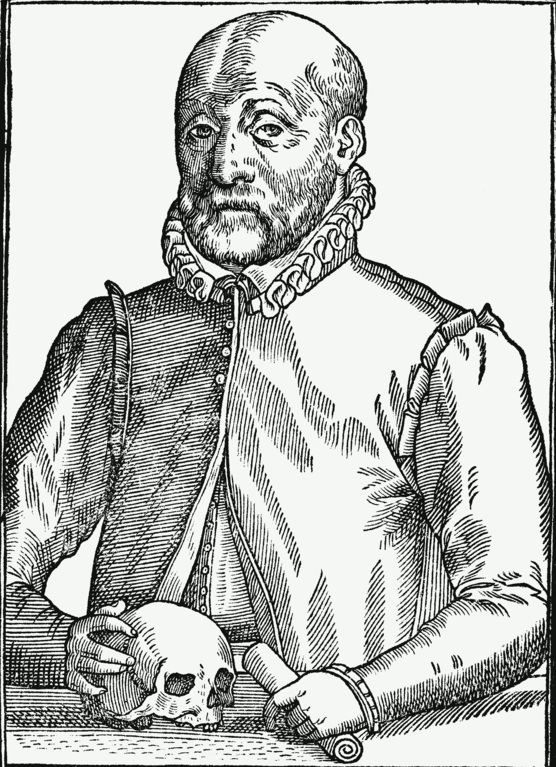Johann Weyer
Johann Weyer or Johannes Wier (Latin: Ioannes Wierus or Piscinarius; 1515 – 24 February 1588) was a Dutch physician, occultist and demonologist, disciple and follower of Heinrich Cornelius Agrippa.
He was among the first to publish against the persecution of witches. His most influential work is his 1563 book titled Praestigiis Daemonum et Incantationibus ac Venificiis (On the Illusions of the Demons and on Spells and Poisons).
Biography
Weyer was born in Grave, a small town in the Duchy of Brabant in the Habsburg Netherlands. He attended the Latin schools in 's-Hertogenbosch and Leuven and when he was about 14 years of age, he became a live-in student of Heinrich Cornelius Agrippa, in Antwerp. Agrippa had to leave Antwerp in 1532 and he and Weyer settled in Bonn, under the protection of prince-bishop Hermann von Wied.
Medical career
From 1534, Weyer studied medicine in Paris and later in Orléans, but it appears unlikely that he obtained the title of Doctor through these studies. Eventually, he practiced as a physician in his native Grave. Weyer was appointed city physician of Arnhem in 1545. In this capacity, he was asked for advice on witchcraft in a 1548 court case involving a fortune teller. In spite of a subsidy from emperor Charles V, the town of Arnhem was no longer able to pay Weyer's salary.
Weyer moved to Cleves in 1550, where he became court doctor to duke William the Rich, through mediation by humanist Konrad Heresbach. He retired from his post in 1578 and was succeeded by his son, Galenus Wier (1547-1619). After retirement he completed his work on a medical book.
Death
He died on 24 February 1588 at the age of 73 in Tecklenburg, while visiting an individual who had fallen ill. He was buried in the local churchyard, which no longer exists.
Authorship on occult subjects
Weyer's works include medical and moral books as well as his more famous critiques of magic and witchcraft. Weyer published his major works on demons, ritual magic, and witchcraft, in which he applied a skeptical medical view to reported wonders of magic or witchcraft.
Weyer criticised the Malleus Maleficarum and the witch-hunting by the Christian and Civil authorities; he is said to have been the first person that used the term mentally ill or melancholy to designate those women accused of practicing witchcraft. In a time when witch trials and executions were just beginning to be common, he sought to derogate the law concerning witchcraft prosecution. He claimed that not only were examples of magic largely incredible but that the crime of witchcraft was literally impossible, so that anyone who confessed to the crime was likely to be suffering some mental disturbance.
Works on demonology
Some scholars have said that Weyer intended to mock the concept of the hellish hierarchy that previous grimoires had established by writing his catalogue of demons.
Nevertheless, while he defended the idea that the Devil's power was not as strong as claimed by the orthodox Christian churches, he also championed the idea that demons did have power and could appear before people who called upon them, creating illusions. He commonly referred to magicians and not to witches when speaking about people who could create illusions, saying they were heretics using the Devil's power to do it. When speaking on witches, he used the term "mentally ill."
In his catalogue of demons, Pseudomonarchia Daemonum (1577), Weyer gave their description and the conjurations needed to invoke them in the appropriate hour and in the name of God and the Trinity. This task, he said, was fulfilled by an exorcist who could compel the Goetic demons to carry out the conjurer's will.
Occult bibliography
- De Praestigiis Daemonum et Incantationibus ac Venificiis (On the Illusions of the Demons and on Spells and Poisons), 1563
- Pseudomonarchia Daemonum (The False Kingdom of the Demons), an appendix to De Praestigiis Daemonum, 1577
- De lamiis liber item de commentitiis jejuniis (A book on witches together with a treatise on false fasting), 1577
Legacy
The church of Tecklenburg displays a plaque in memory of Weyer and in 1884 the town erected a tower in his honor, the Wierturm. The Dutch human rights organization for health workers is named the Johannes Wier Foundation after him.
